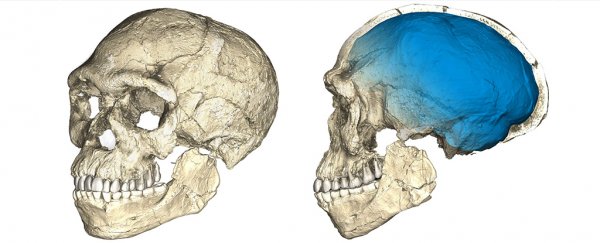Researchers have used new dating techniques to confirm that human fossils unearthed in Morocco are roughly 300,000 years old.
The landmark discovery is forcing a rethink not only on how the first populations of Homo sapiens developed at least 100,000 years earlier than previously thought, but how these early human populations spread themselves across the continent before setting off to conquer the world.
Today, Jebel Irhoud is a rocky outcrop about 100 kilometres (62 miles) west of the Moroccan city of Marrakesh. But wind back the clock thousands of years, and it was once a cave site, and home to our ancient human relatives.
A handful of human remains were uncovered there in the 1960s, displaying characteristics that made researchers think they belonged to humans who evolved far on the fringes of where it was believed Homo sapiens first evolved in east Africa.
In 2004, a new excavation project opened. This has added to the previous finds by providing researchers with stone artefacts, remains of animals including gazelles and wildebeest, and a partial skull, teeth, and long bones belonging to at least five individuals.
Led by Max Planck Institute for Evolutionary Anthropology and the Moroccan National Institute for Archaeology and Heritage, an international team of scientists applied advanced dating technology on both the new materials and earlier finds to develop a clearer picture of their history.
A process called thermoluminescence dating measures electrons trapped in pockets of crystals as a material is heated by fire or sunlight.
The flint tools they tested with this method proved to be approximately 300,000 years - much older than previous estimates of roughly 200,000 years ago for the emergence of anatomically modern humans found to the east.
"Well-dated sites of this age are exceptionally rare in Africa, but we were fortunate that so many of the Jebel Irhoud flint artefacts had been heated in the past," geochronology expert Daniel Richter from the Max Planck Institute said in a press statement.
Another dating process they used was electron spin resonance dating, often applied to buried teeth to provide a good indication of their age. While reliable, the method's accuracy relies on knowing the background radiation of the sample.
This process had Initially dated a mandible discovered in the 1960s to 160,000 years old, but a more accurate analysis of the radioactivity in the surrounding sediment came up with a reading that once again pointed at about 300,000 years.
"In the late '80s, there were the first results of anatomically modern humans in Israel at about 100,000 years," says Rainer Grün of the Australian Research Centre for Human Evolution, whose research helped make the dating processes a little less destructive than usual.
"In the '90s, there were a few sites found in Ethiopia dated to 200,000 years, and now with these results the origins of modern humans are further pushed back to 300,000 years."
Genetic analysis on the bones of recent Homo sapien cousins, the Neanderthals and Denisovans, has indicated that we parted ways as distinct populations more than 500,000 years ago.
While it was speculated that their features might have been a mix of older and more recent characteristics, until now, fossil evidence has been scant.
Scans of the skulls and statistical shape analysis based on hundreds of 3D measurements indicate that while the skull's braincase is a little more elongated and archaic-looking, their face and teeth are indistinguishable from those of modern humans.
You can see both of these features in the animation below:

These characteristics could represent a structure near the beginning of the evolution of the more globular brain shape that humans developed around 130,000 years ago, providing the best snapshot to date of pre-modern Homo sapiens.
The mix of methods used might not necessarily be the final word on the age of the fossils or their exact relationship with humans, but they do combine to produce some pretty strong evidence that populations of early Homo sapiens had spread to populate north-west Africa long before previous estimates claimed.
Taken in context with a 260,000-year-old skull fragment found in South Africa that has been identified as belonging to an early human, and remains found in Ethiopia dated to 195,000 years, the evolution of early Homo sapiens appears to have taken place over the whole of Africa.
"We used to think that there was a cradle of mankind 200 thousand years ago in east Africa, but our new data reveal that Homo sapiens spread across the entire African continent around 300 thousand years ago," says palaeoanthropologist Jean-Jacques Hublin from the Max Planck Institute.
"Long before the out-of-Africa dispersal of Homo sapiens, there was dispersal within Africa."
The find still leaves plenty of unanswered questions.
While some of their more primitive characteristics look similar to those of other ancient humans, it's not clear whether they all retained these traits over time, or if there was ongoing mixing of populations.
The Sahara desert makes travelling by foot into north-west Africa challenging today, but with the climate swinging from wet to dry every 20,000 years or so, it might have allowed for an easier passage for early humans.
Could culture and technology have been swapped between these spread-out populations of early Homo sapiens?
Grün told ScienceAlert the fact that the technology used by those at Jebel Irhoud looked so similar to tools found as far as the Middle East, and later in Europe, means we could consider the possibility of some form of cultural exchange.
"So maybe there was some technological transfer between different human groups," says Grün.
Finding more fossils and collecting more accurate dates from existing finds will no doubt help fill in more of the starting chapters of our story.
